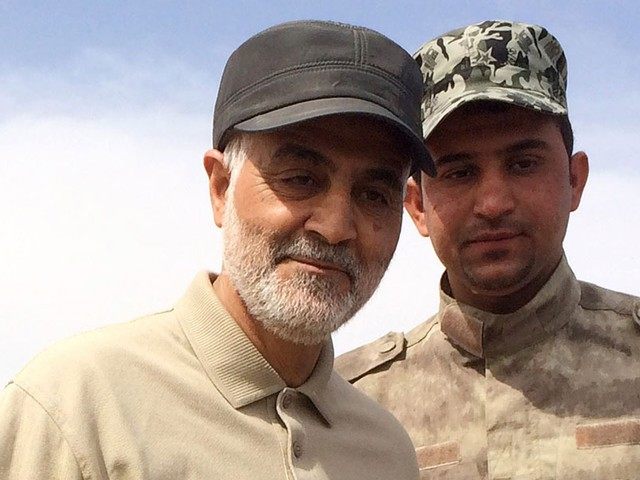Qassem Soleimani, the commander of Iran’s elite Quds Force squad, was reportedly injured while fighting in Syria last month. According to an Iranian opposition group, he was far more severely injured than Tehran wants to admit.
Soleimani might be out of action for a long time to come, or even mortally wounded, according to the People’s Mujahedeen of Iran (Mujahadeen-e-Khalq, or “MEK” for short)–a militant Iranian group with a checkered history of Marxism but respectable size, dedicated to overthrowing the current regime. The MEK is confident of its sources inside the Revolutionary Guard, and stands aggressively behind its claim that the Iranian government is concealing the severity of his injuries.
“We’re very confident about the information we have. If he is alive and well, as the regime claims, it is easy for them to dispel the rumors by showing him at a public event,” MEK spokesman Shahin Gobadi told Fox News. “At the most recent meeting Ayatollah Khamanei had with the commanders of the IRGC this week, Soleimani was nowhere to be found. Every time there have been such events he has always been on the front row featured very prominently.”
Tehran finally conceded that Soleimani was injured by shrapnel while fighting on behalf of the Assad regime near Aleppo, Syria a few weeks ago, following reports in Iranian state media agencies that Soleimani was not hurt at all. The Iranian government had previously described reports of his injury as a “sheer lie.” The Iranian Mehr News Agency refuted the claims on Twitter by publishing an undated photo of the general last week:
Despite rumors about General Qassem Suleimani sustaining injuries, new photo shows him safe & sound. pic.twitter.com/ioaJWaWcGN
— Mehr News Agency (@MehrnewsCom) November 24, 2015
According to the MEK report, he “suffered severe shrapnel wounds, including in the head” when his vehicle was blasted by the U.S.-backed Free Syrian Army.
“Due to the severity of his wounds, Soleimani was immediately airlifted by an IRGC helicopter to Damascus and, after receiving preliminary treatment, was transferred to Tehran. He is hospitalized at IRGC Baqiyatallah Hospital,” the MEK claims. “So far, he has undergone at least two surgeries.”
The report went on to claim the Iranian Revolutionary Guard Corps has “imposed a total blackout to prevent any leaks” about Soleimani’s condition, forbidding him from receiving visitors, and ordering hospital staff to avoid answering any questions about him.
The Iranian regime might be working a bit too hard to shield Soleimani’s condition, with state-run media portraying the injured general laughing that his “fervent wish to be martyred has not come true,” accompanied by a four-month-old photograph of him.
If Soleimani is indeed gravely or mortally injured, it would come as a blow to Iranians, who give him very high marks in popularity polls – Fox News describes him as the “face of the Iranian military.” Few Americans would shed a tear, however, given Soleimani’s involvement in terrorist operations across the region, including attacks on U.S. soldiers in Iraq.
Soleimani’s condition is part of a larger controversy brewing in Iran, as the government begins to grudgingly acknowledge it has suffered significant battlefield losses in Syria. The MEK claims some 3,000 Revolutionary Guard troops have been killed, including 16 senior officers. The government has formally acknowledged one high-ranking casualty, Soleimani’s deputy General Hossein Hamadani. An AFP report from late October mentions two colonels and nine other members of the IRGC whose deaths appear to have been conceded by the government.
The Sydney Morning Herald reported this week on a “flurry of reports in Iran’s official and semi-official news outlets” about casualties in military and militia units fighting in Syria, conceding at least 67 Iranian deaths in October, after months of stubborn silence about battlefield losses. The Herald notes that Iranian casualties appear to have surged after Russia began its air strikes in Syria, increasing the tempo of operations against opponents of the Assad regime.
Perhaps the number of deaths in Syria has grown too large for Tehran to conceal, given all the relatives of fallen troops back home. Another possibility was suggested to the Sydney Morning Herald by Ali Alfoneh of the Foundation for the Defense of Democracies: the regime is “proud” of their involvement in Syria, and desires recognition for the sacrifices of its soldiers.
“The Iranian regime is showing its importance in Syria, using all its propaganda machinery to publicise the names and information of individuals who were martyred,” said Alfoneh. It is theorized that Tehran might once have worried about public opposition to spilling Iranian blood in the name of Bashar Assad, but the rise of the virulently anti-Shiite Islamic State increased popular support for Syrian intervention.
Nevertheless, AFP reports some unrest among the Iranian population over mounting Syrian war casualties, including social media complaints that senior officers are being killed too easily, and fears that Iran’s military will be weakened by its Syrian commitment and unable to repel future assaults from enemies like ISIS. The deputy commander of the IRGC, Brigadier General Hossein Salami, even felt obliged to appear on state television and explain why so many “advisers” from Iran have lately been dying in Syria.
The Iranian regime must now find a way to convince its people that their soldiers are dying in battle against ISIS, rather than the more moderate Western-backed groups they’re actually fighting – an obvious reason to downplay the scenario described by the MEK, in which Iran’s most popular military commander was severely injured by Free Syrian Army forces.

COMMENTS
Please let us know if you're having issues with commenting.